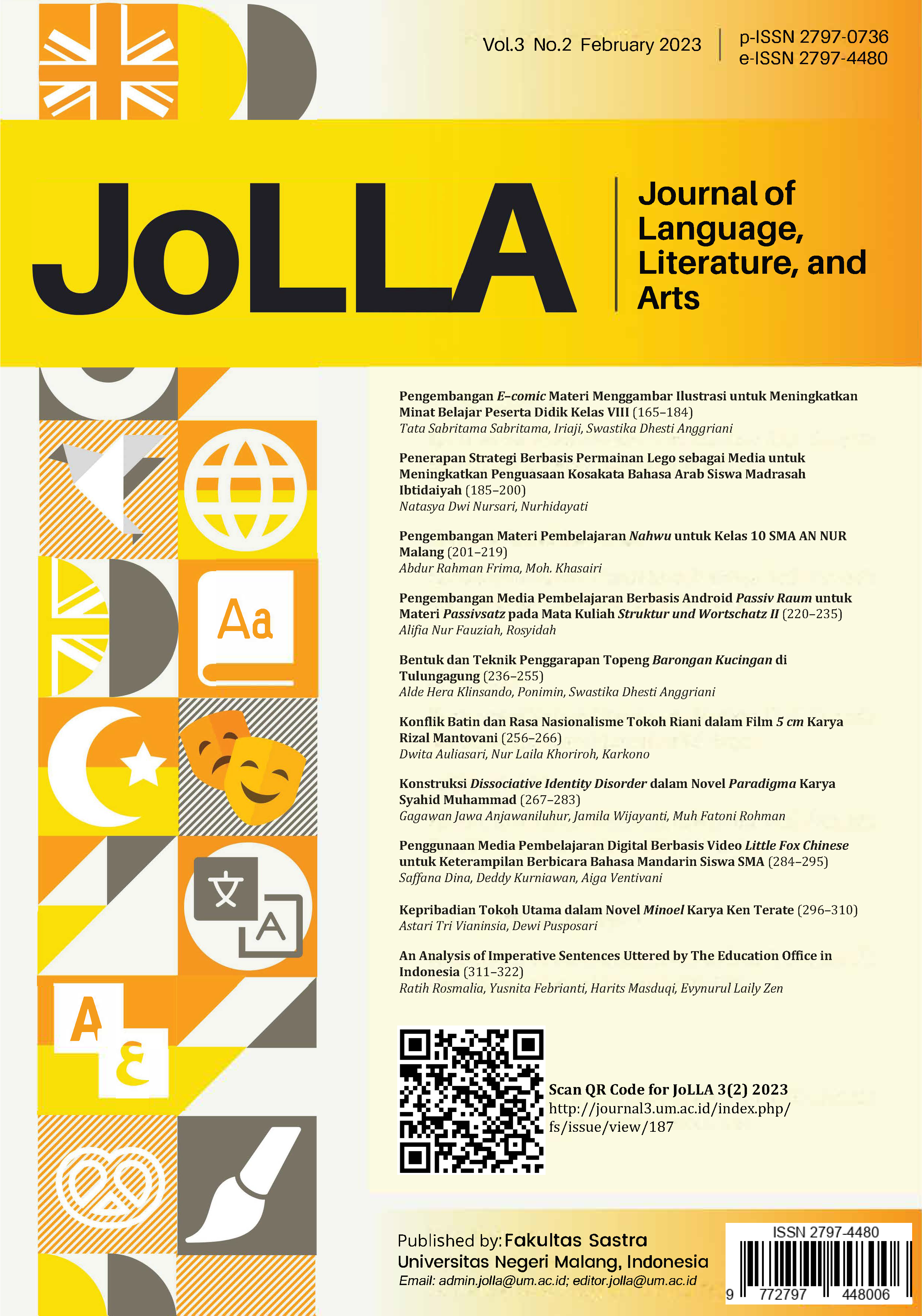An Analysis of Imperative Sentences Uttered by The Education Office in Indonesia
DOI:
https://doi.org/10.17977/um064v3i22023p311-322Keywords:
power relation in the workplace, directive speech act, imperative sentencesAbstract
The power relations between high rank officials and their staff seem to shape various forms of communication patterns, especially in terms of commanding or directing. In this research, the researcher discusses the use of command utterances by high rank officials and staff at the Education Office of Malang Regency in giving orders to internship students. To perform this analysis, the researcher employed a descriptive-qualitative approach with the Speech Act theory suggested by Yule (1996) and Searle (1985) as an analytical tool. The result shows that there are three types of directive speech acts namely implicit ordering, commanding, and ordering. The high rank officials and staff at the Education Office of Malang Regency had great respect for someone who had no position, for example an internship student. This could be seen by always using the word “please” when ordering. The expression of respect is also shown by saying “thank you” after the completion of certain task. The result of this current research provides an overview of how communication in the workplace embodies power relations, especially in formal settings such as government offices. Communication between the Malang Regency Education Office and internship students can be seen as an example that power relations with negative connotations do not always occur in every government agency for the sake of humanity and mutual respect to all people in the agency.
Keywords: power relation in the workplace; directive speech act; imperative sentences
Analisis Ujaran Kalimat Imperatif di Lingkungan Dinas Pendidikan di Indonesia
Relasi kekuasaan antara pemimpin dan stafnya tampak membentuk berbagai bentuk pola komunikasi, terutama dalam hal memerintah atau mengarahkan. Dalam penelitian ini, oleh karena itu, peneliti membahas penggunaan ujaran perintah oleh staf dan kepala bidang di Dinas Pendidikan Kabupaten Malang dalam memberikan perintah kepada pekerja magang. Untuk melakukan analisis ini, peneliti menggunakan pendekatan deskriptif-kualitatif dengan menggunakan teori Speech Act yang dikemukakan oleh Yule (1996) dan Searle (1985) sebagai alat analisis. Hasil yang diperoleh menunjukkan bahwa terdapat tiga jenis tindak tutur direktif yang ditemukan, yaitu implicit ordering, commanding, dan ordering. Para pimpinan dan staf di Dinas Pendidikan Kabupaten Malang sangat menghormati seseorang yang tidak memiliki jabatan, misalnya mahasiswa magang. Hal ini terlihat dari tindakannya yang selalu menggunakan kata “tolong” saat memesan. Ungkapan rasa hormat juga ditunjukkan dengan mengucapkan “terima kasih” setelah selesainya suatu kegiatan. Hasil penelitian saat ini memberikan gambaran tentang bagaimana komunikasi di tempat kerja mewujudkan hubungan kekuasaan, terutama dalam pengaturan formal seperti kantor-kantor pemerintah. Komunikasi antara Dinas Pendidikan Kabupaten Malang dengan mahasiswa magang dapat dilihat sebagai contoh bahwa relasi kuasa yang berkonotasi negatif tidak terjadi di setiap instansi pemerintah demi kemanusiaan dan saling menghormati kepada semua orang termasuk dalam instansi tersebut.
Kata Kunci: relasi kuasa di tempat kerja; tindak tutur direktif; kalimat perintah
References
Balan, Sergiu. (2010). M. Foucault’s View on Power Relations. Cogito. Multidisciplinary Research Journal, 2, 55-61.
Birner, B.J. (2013). An Introduction to Pragmatics. Wiley.
Della, F., & Sembiring, B. (2018). An analysis of directive speech acts by Searle Theory in “Sleeping Beauty” Movie Script. Journal of English Education and Teaching, 2(1), 22–27. doi.org/10.33369/jeet.2.1.22-27.
Foster, A. (2019), "Leading by Limitation? Language and Communication within the Workplace", Journal of Work-Applied Management, 11(2), 133-142.
Hamdany, A.M., & Damanhuri, A. (2017). Speech Act Used in the Workplace in 500 Days of Summer Movie. Language Horizon. 5(1), 30-38. https://ejournal.unesa.ac.id/index.php/language-horizon/article/view/18260/16648
Haucsa, G. M., Marzuki, A. G., Alek, A., & Hidayat, D. N. (2020). Illocutionary Speech Acts Analysis in Tom Cruise's Interview. Academic Journal Perspective: Education, Language, and Literature, 8(1), 11-19.
Hidayah, A. (2019). An Analysis of Directives Speech Acts in Film Script of Iron Man 2. Surakarta English and Literature Journal, 2(1), 1-8. https://ejournal.unsa.ac.id/index.php/selju/article/download/275/182
Isaraj, M., & Taçi, J. (2021). The imperative sentences with let in the English language: Their distinctive fea-tures and counterparts in Albanian language. Turkish Journal of Computer and Mathematics Educa-tion, 12(12), 1065-1069. Retrieved from https://www.proquest.com/scholarly-journals/imperative-sentences-with-let-english-language/docview/2622809773/se-2
Mikkola, L., & Valo, M. (Eds.). (2020). Workplace Communication. Abingdon: Routledge.
Nassaji, Hossein. (2015). Qualitative and Descriptive Research: Data Type versus Data Analysis. Language Teaching Research. 19, 129-132. doi: 10.1177/1362168815572747.
Prawita, A,. & Utomo, A.P.Y. (2020). Analysis of Directive Speech Acts in Mata Najwa YouTube Channel "Because of Corona: Why Indonesia Is Not Like Singapore. AKSIS: Jurnal Pendidikan Bahasa dan Sastra Indonesia, 4(1), 101-110. https://doi.org/10.21009/AKSIS.040109.
Puri, Anindita Dewangga. (2015). Directive Speech Acts Showing Leadership Style Used by Miranda Priest-ly in the Devil Wears Prada Movie (Undergraduate Thesis, Sanata Dharma University, Yogyakarta, Indonesia). https://repository.usd.ac.id/529/2/104214048_full.pdf
Rönnlöf, Hanna. (2014). Language Practices in The Workplace Ethnographic Insights from Two Multilingual Companies in Sweden (Bachelor Degree Project, Stockholm Universität, Stockholm, Sweden). https://www.diva-portal.org/smash/get/diva2:733464/FULLTEXT01.pdf
Sadock, J. (2004). Speech acts. The handbook of Pragmatics, 53-73. https://semantics.uchicago.edu/kennedy/classes/f09/semprag1/sadock.pdf
Searle, J. R. (1985). Expression and meaning: Studies in the Theory of Speech Acts. Cambridge University Press.
Subandi. (2011). Deskripsi Kualitatif sebagai Satu Metode dalam Penelitian Pertunjukan. Harmonia, 11(2), 173-179. https://journal.unnes.ac.id/nju/index.php/harmonia/article/view/2210/2272
Trianjdjojo, Indriani. (2014). Power Relation: Gaya Bahasa Penggambaran Kekuasaan. CULTURE. 1(1). https://unaki.ac.id/ejournal/index.php/jurnalculture/article/download/88/9
Varma, S. B., et al. (2021). Workplace Communication Hindrances: The Contextual, Structural and Behav-ioral Factors. International Journal of Academic Research in Business and Social Sciences, 11(9), 1844–1855.
Yule, G. (1996). Pragmatics. Oxford University Press.
Downloads
Published
How to Cite
Issue
Section
License
Copyright (c) 2023 Ratih Rosmalia, Yusnita Febrianti, Harits Masduqi, Evynurul Laily Zen

This work is licensed under a Creative Commons Attribution-ShareAlike 4.0 International License.





























